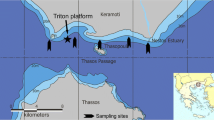Abstract
Since 1998, ferry observations have been carried out in the Marsdiep tidal inlet (Dutch Wadden Sea), using amongst other instruments a vessel-mounted acoustic Doppler current profiler (ADCP). Besides 32 cross-sections a day of current velocity data, the instrument also records the echo intensity, which has been interpreted in terms of suspended sediment concentration (SSC) before (Thorne and Hanes, Cont Shelf Res 22:603–632, 2002). However, we show herein that the random phase scattering model as outlined by Thorne and Hanes (Cont Shelf Res 22:603–632, 2002), predicts unrealistically high values of SSC if the depth-averaged current velocity exceeds approximately 0.7 m/s. Therefore, we extended the random phase scattering model by including scattering by turbulence-induced variability in SSC. The important mechanism is that when SSC fluctuations are present at length, scales of the order of the acoustic wavelength, the phase of the returned signal is no longer random and causes stronger backscatter. Such SSC fluctuations occur as a result of turbulent eddies in combination with an SSC gradient. The extended model was compared with data of two field surveys carried out in the Marsdiep inlet. The extended model, when compared with the classical random phase model, showed a large improvement of accuracy of the estimated SSC, which allows us to apply the model to the ferry data set to analyse suspended sediment transports through the Marsdiep tidal inlet.

















Similar content being viewed by others
Notes
The acoustic intensity is expressed in decibels, derived from the ADCP’s internal unit counts. The offset of the decibel scale is arbitrary, as the system’s specifications (Nortek 1998) provide the proportionality factor between counts and decibels only.
In fact, the Nortek ADCP used during the survey(s) AS26 (and AS27) was replaced by a new Nortek ADCP operating at the same frequency for AS29. During a test survey when the old and new ADCPs were deployed in 20-min shifts, it turned out that backscatter intensity of the new ADCP was systematically lower by an amount of 8 dB. This is probably due to different internal electrical circuits, resulting in a different offset in the relationship between counts (the ADCP’s internal parameter) and decibels. The effect of the systematic lower echo intensity has been accounted for by adjusting the offset in the counts to decibels relationship, so that the value for K R can be assumed to be constant.
A typical frequency of a mid-range ADCP, applicable for coastal waters is about 1 MHz, which corresponds to a Bragg length of about 0.7 mm.
References
Clay C, Medwin H (1977) Acoustical oceanography. Wiley, New York
Fugate D, Friedrichs C (2002) Determining concentration and fall velocity of estuarine particle populations using ADV, OBS and LISST. Cont Shelf Res 22:1867–1886
Goodman L (1990) Acoustic scattering from ocean microstructure. J of Geophys Res 95(C7):11557–11573
Holdaway G, Thorne P, Flatt D, Jones S, Prandle D (1999) Comparison between ADCP and transmissometer measurements of suspended sediment concentration. Cont Shelf Res 19:421–441
Lane A, Prandle D, Harrison A, Jones P, Jarvis C (1996) Measuring fluxes in tidal estuaries: sensitivity to instrumentation and associated data analyses. Estuar Coast Shelf Sci 45:433–451
Lee GH, Dade W, Friedrichs C, Vincent C (2003) Spectral estimates of bed shear stress using suspended-sediment concentrations in a wave-current boundary layer. J Geophys Res 108(C7):3208–3223
Ludwig K, Hanes D (1990) A laboratory evaluation of optical backscatterance suspended solids sensors exposed to sand-mud mixtures. Mar Geol 94:173–179
Nortek (1998) Nortek VM-ADP, operation manual. Norway
Ridderinkhof H, Haren HV, Eijgenraam F, Hillebrand T (2002) Ferry observations on temperature, salinity and currents in the Marsdiep tidal inlet between the North sea and Wadden sea. In: Flemming NC et al (eds) Operational oceanography: implementation at the European and regional scales. Proceedings of the second international conference on EUROGOOS, Elsevier Oceanogr Ser, vol 66, pp 139–148
Ross T, Lueck R (2003) Sound scattering from oceanic turbulence. Geophys Res Lett 30(6):1344–1348
Stacey M, Monismith S, Burau J (1999) Reynolds stress in unstratified tidal flow. J Geophys Res 104:10933–10949
Tennekes H, Lumley J (1972) A first course in turbulence. MIT Press, Cambridge, Massachusetts
Thorne P, Hanes D (2002) A review of acoustic measurement of small-scale sediment processes. Cont Shelf Res 22:603–632
Acknowledgements
We thank Margriet Hiehle for her help with the data processing and the crew of the R.V. Navicula for their help in collecting the data during the two surveys.
Author information
Authors and Affiliations
Corresponding author
Additional information
Responsible editor: Paulo Salles
Rights and permissions
About this article
Cite this article
Merckelbach, L.M., Ridderinkhof, H. Estimating suspended sediment concentration using backscatterance from an acoustic Doppler profiling current meter at a site with strong tidal currents. Ocean Dynamics 56, 153–168 (2006). https://doi.org/10.1007/s10236-005-0036-z
Received:
Accepted:
Published:
Issue Date:
DOI: https://doi.org/10.1007/s10236-005-0036-z




